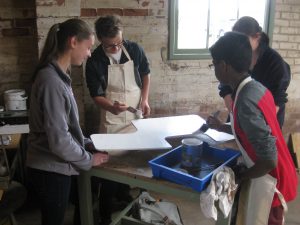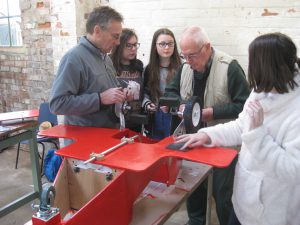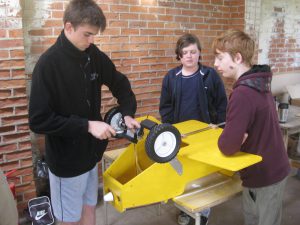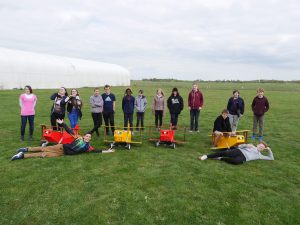Essex Students build pedal planes at Stow Maries Great War Aerodrome
During the recent Easter holidays sixteen pupils from Essex Schools spent four days building four pedal planes. The pupils were mentored and supervised by volunteers from the Stow Maries Great War Aerodrome.
Pupils from the following schools took part in the Little Planes Project:-
Basildon Academy, Beauchamps High School, Billericay School, Passmores Academy, Stewards Academy, Westcliff High School for Boys, Woodlands Secondary School.
Sponsored by :- The Essex Employment & Skills Board
Education & Industry STEM Programme
The RE Workshop was busy for four days last week with groups of young people making pedal planes.
The Little Plane project was inspired by our very own Ron and taken forward under the auspices of Essex County Council. Ron set up the workshop by laser cutting all the wooden parts and making many other components such as pedals and other fittings. Denis, Ian R, Roger B and other volunteers supervised the young mechanics who assembled and painted the little planes.
The project was a great success considering that most of the young people had never even picked up a screwdriver before. They are to be commended for their enthusiasm and determination to get the job finished. We would like to thank Ron for all his hard work and expertise.
One of them, Sri Haran, made his own report of the project
From the 10th – 14th April Stow Maries Great War Aerodrome ran the Little Planes Project. The premise was rather simple; four teams of four Year 9-10s would construct a small pedal plane in four days whilst also getting to experience working in engineering and aeronautical fields. The project was run by volunteer workers and I would have to say, the whole thing was very enjoyable.
On the first day, we were assigned our teams and deployed to our work stations to start the fuselage. Although the sanding was laborious, it was worth it in the end when we were able to see the progress we had made by the end of the day.
On the next day, we began work on the painting with the primer coat and the crank for the pedals. There was a lot of work to be done so we really had to get stuck in and I think some of us managed to get more paint on ourselves than on our planes. Nonetheless it was an enjoyable experience. Following this the third day was when we applied our paint and sanded off all of the remaining rough edges ahead of the final session.
At the time of writing I have yet to do this final day but it does look plausible that we may finish; we really have to hope. Regardless of whether we finish or not, I would say that we all look forward to seeing our little planes in the end.
The construction aspect in itself, however, isn’t always the most interesting when it comes to drying paint, waiting for it to settle or just waiting for other teams to finish, but we were very lucky to be hosted by such wonderful engineers and experts that we barely noticed!
During the breaks a number of us experienced VR plane simulations and others even received their own boomerangs. We’ve also launched rockets, flown drones, watched real planes take off and land and all this whilst learning more about the history of the site and the science of aerodynamics.
Because of all these activities I would like to thanks all of the volunteers who gave up their time and energy putting up with all of us to make the entire event just that little bit more fun.
If you didn’t believe me, here’s what some of my peers said
Lewis: “Really fun.”
Alicia: “Banterful.”
Jake: “Thoroughly enjoyable.”
Sonny: “Very rewarding”




